power steering Alfa Romeo 156 2004 Owner handbook (in English)
[x] Cancel search | Manufacturer: ALFA ROMEO, Model Year: 2004, Model line: 156, Model: Alfa Romeo 156 2004Pages: 357, PDF Size: 5.04 MB
Page 19 of 357
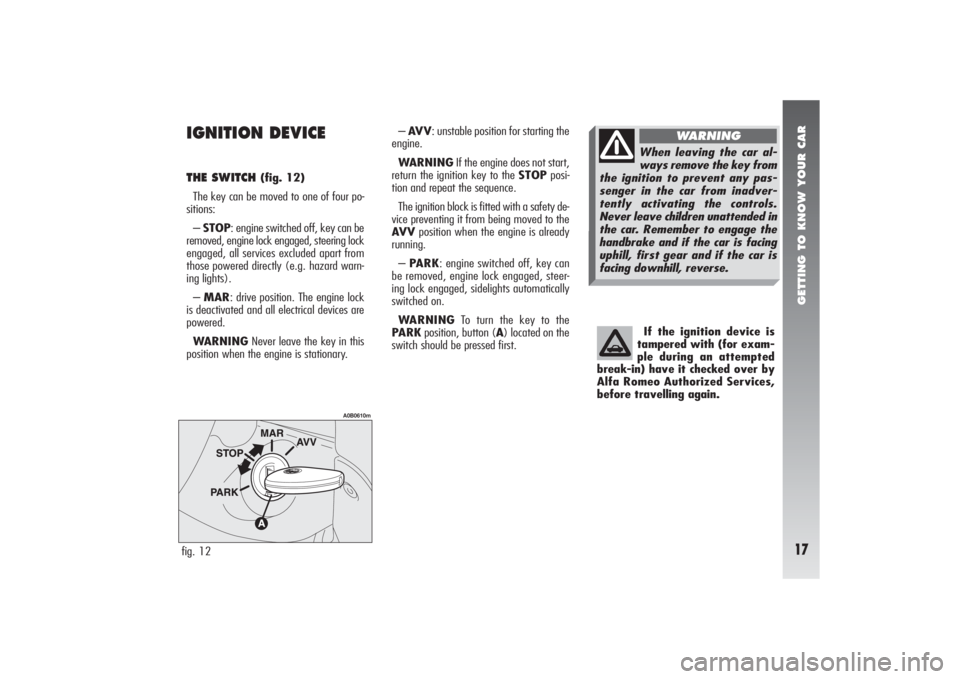
GETTING TO KNOW YOUR CAR17
IGNITION DEVICE THE SWITCH
(fig. 12)
The key can be moved to one of four po-
sitions:
– STOP: engine switched off, key can be
removed, engine lock engaged, steering lock
engaged, all services excluded apart from
those powered directly (e.g. hazard warn-
ing lights).
– MAR: drive position. The engine lock
is deactivated and all electrical devices are
powered.
WARNINGNever leave the key in this
position when the engine is stationary.– AV V: unstable position for starting the
engine.
WARNINGIf the engine does not start,
return the ignition key to the STOPposi-
tion and repeat the sequence.
The ignition block is fitted with a safety de-
vice preventing it from being moved to the
AV Vposition when the engine is already
running.
– PARK: engine switched off, key can
be removed, engine lock engaged, steer-
ing lock engaged, sidelights automatically
switched on.
WARNINGTo turn the key to the
PARKposition, button (A) located on the
switch should be pressed first.If the ignition device is
tampered with (for exam-
ple during an attempted
break-in) have it checked over by
Alfa Romeo Authorized Services,
before travelling again.
fig. 12
A0B0610m
When leaving the car al-
ways remove the key from
the ignition to prevent any pas-
senger in the car from inadver-
tently activating the controls.
Never leave children unattended in
the car. Remember to engage the
handbrake and if the car is facing
uphill, first gear and if the car is
facing downhill, reverse.
WARNING
Page 182 of 357

GETTING TO KNOW YOUR CAR
180
The heart of the VDC system is the VDC
control unit which with the data supplied by
the sensors installed on the car, calculates
the centrifugal forces generated when the
car is cornering. The yawing sensor detects
the rotations of the car around its own ver-
tical axis. The centrifugal forces generated
when the car is cornering are detected by
a highly sensitive lateral acceleration sensor.
The stabilising action of the VDC system is
based on calculations made by the
system’s electronic control unit which
processes the signals received from the
steering wheel rotation, lateral acceleration
and individual wheel rotation sensors. These
signals allow the control unit to recognise
the manoeuvre the driver intends to do
when turning the steering wheel.
The control unit processes the information
received from the sensors and is therefore
capable of detecting the position of the car
and comparing it with the trajectory the dri-
ver would like to follow instant by instant.
In the event of a discrepancy, the control
unit chooses and commands the most suit-
able action to bring the car back to the re-
quired course within a fraction of a second:
braking one or more wheels at a different
braking force and, if necessary it reduces the
power transmitted by the engine. The corrective actions are changed and con-
trolled continuously until the car returns to
the required course.
The action of the VDC system considerably
increases the active safety of the vehicle un-
der many critical situations and it is partic-
ularly useful also when the road surface grip
conditions change.
For the VDC, ASR and ABS
systems to work correctly,
the tyres must be of the same
brand and type on all wheels, in
perfect conditions and above all of
the specified type, brand and size.
WARNING
During use of the compact
spare wheel, the VDC sys-
tem continues working. It should be
borne in mind that the spare wheel
is smaller than a normal tyre,
therefore its grip is lower than that
of the other tyres of the car.
WARNING
VDC SYSTEM OPERATIONThe VDC system turns on automatically
when the car is started and cannot be
switched off. It is however possible to cut
off operation of the ASR system pressing the
corresponding button on the centre console.
The main components of the VDC system
are:
– an electronic control unit which
processes the signals received from the var-
ious sensors and brings about the most ap-
propriate strategy;
– a sensor that detects the position of the
steering wheel;
– four sensors that detect the rotation
speed of each wheel;
– a sensor that detects rotation of the car
around the vertical axis;
– a sensor that detects lateral acceleration
(centrifugal force).
Page 193 of 357
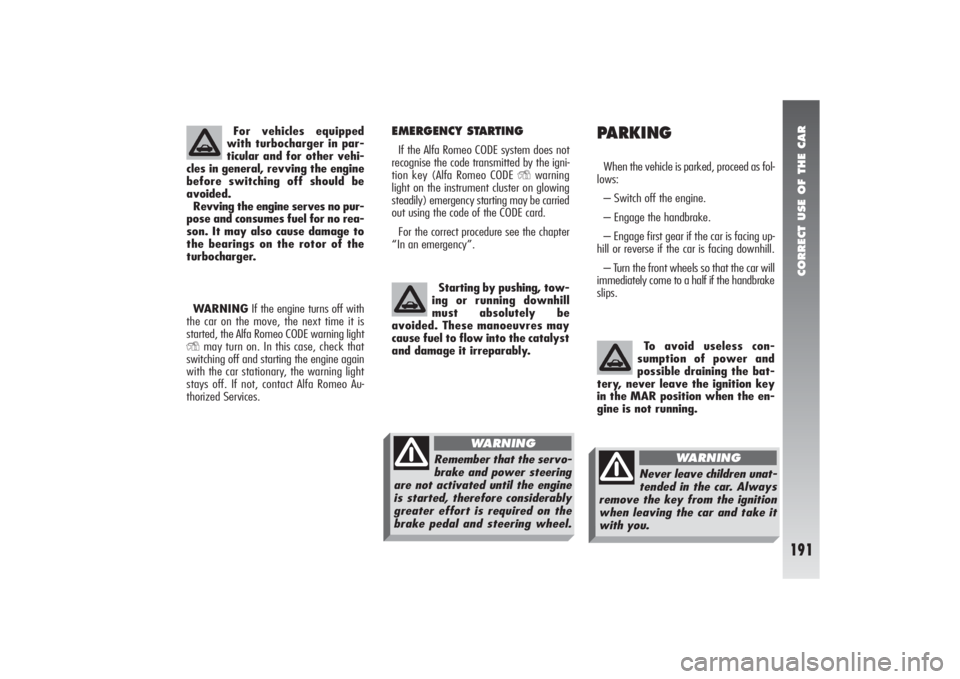
CORRECT USE OF THE CAR
191
EMERGENCY STARTINGIf the Alfa Romeo CODE system does not
recognise the code transmitted by the igni-
tion key (Alfa Romeo CODE
Y
warning
light on the instrument cluster on glowing
steadily) emergency starting may be carried
out using the code of the CODE card.
For the correct procedure see the chapter
“In an emergency”.
PARKINGWhen the vehicle is parked, proceed as fol-
lows:
– Switch off the engine.
– Engage the handbrake.
– Engage first gear if the car is facing up-
hill or reverse if the car is facing downhill.
– Turn the front wheels so that the car will
immediately come to a half if the handbrake
slips. Starting by pushing, tow-
ing or running downhill
must absolutely be
avoided. These manoeuvres may
cause fuel to flow into the catalyst
and damage it irreparably.
To avoid useless con-
sumption of power and
possible draining the bat-
tery, never leave the ignition key
in the MAR position when the en-
gine is not running.
For vehicles equipped
with turbocharger in par-
ticular and for other vehi-
cles in general, revving the engine
before switching off should be
avoided.
Revving the engine serves no pur-
pose and consumes fuel for no rea-
son. It may also cause damage to
the bearings on the rotor of the
turbocharger.
WARNINGIf the engine turns off with
the car on the move, the next time it is
started, the Alfa Romeo CODE warning lightY
may turn on. In this case, check that
switching off and starting the engine again
with the car stationary, the warning light
stays off. If not, contact Alfa Romeo Au-
thorized Services.
Remember that the servo-
brake and power steering
are not activated until the engine
is started, therefore considerably
greater effort is required on the
brake pedal and steering wheel.
WARNING
Never leave children unat-
tended in the car. Always
remove the key from the ignition
when leaving the car and take it
with you.
WARNING
Page 194 of 357
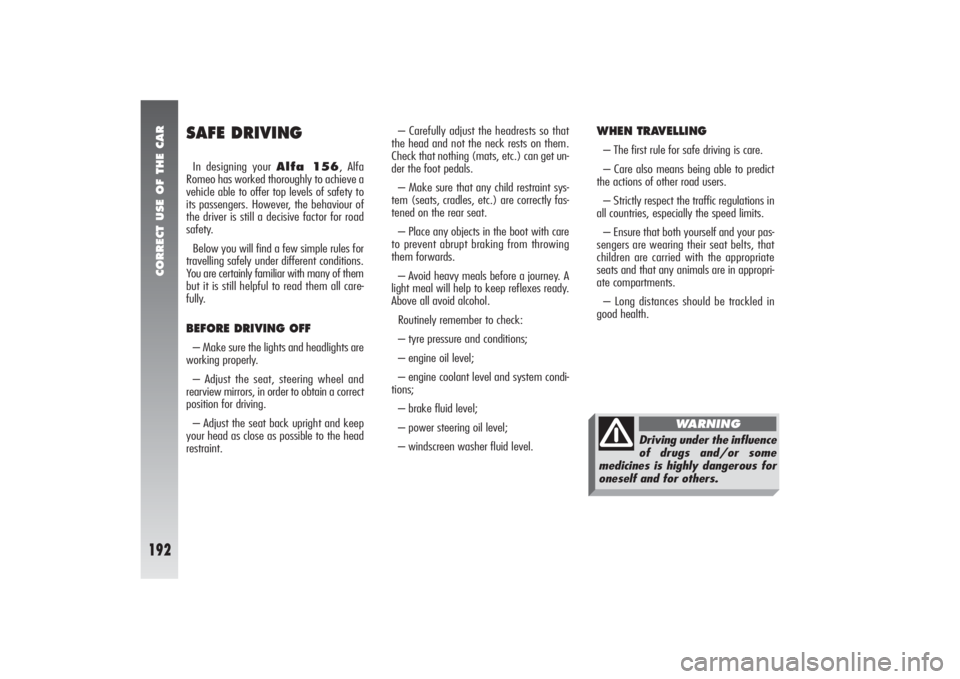
CORRECT USE OF THE CAR
192
SAFE DRIVINGIn designing your Alfa 156, Alfa
Romeo has worked thoroughly to achieve a
vehicle able to offer top levels of safety to
its passengers. However, the behaviour of
the driver is still a decisive factor for road
safety.
Below you will find a few simple rules for
travelling safely under different conditions.
You are certainly familiar with many of them
but it is still helpful to read them all care-
fully.BEFORE DRIVING OFF– Make sure the lights and headlights are
working properly.
– Adjust the seat, steering wheel and
rearview mirrors, in order to obtain a correct
position for driving.
– Adjust the seat back upright and keep
your head as close as possible to the head
restraint.– Carefully adjust the headrests so that
the head and not the neck rests on them.
Check that nothing (mats, etc.) can get un-
der the foot pedals.
– Make sure that any child restraint sys-
tem (seats, cradles, etc.) are correctly fas-
tened on the rear seat.
– Place any objects in the boot with care
to prevent abrupt braking from throwing
them forwards.
– Avoid heavy meals before a journey. A
light meal will help to keep reflexes ready.
Above all avoid alcohol.
Routinely remember to check:
– tyre pressure and conditions;
– engine oil level;
– engine coolant level and system condi-
tions;
– brake fluid level;
– power steering oil level;
– windscreen washer fluid level.
WHEN TRAVELLING– The first rule for safe driving is care.
– Care also means being able to predict
the actions of other road users.
– Strictly respect the traffic regulations in
all countries, especially the speed limits.
– Ensure that both yourself and your pas-
sengers are wearing their seat belts, that
children are carried with the appropriate
seats and that any animals are in appropri-
ate compartments.
– Long distances should be trackled in
good health.
Driving under the influence
of drugs and/or some
medicines is highly dangerous for
oneself and for others.
WARNING
Page 195 of 357
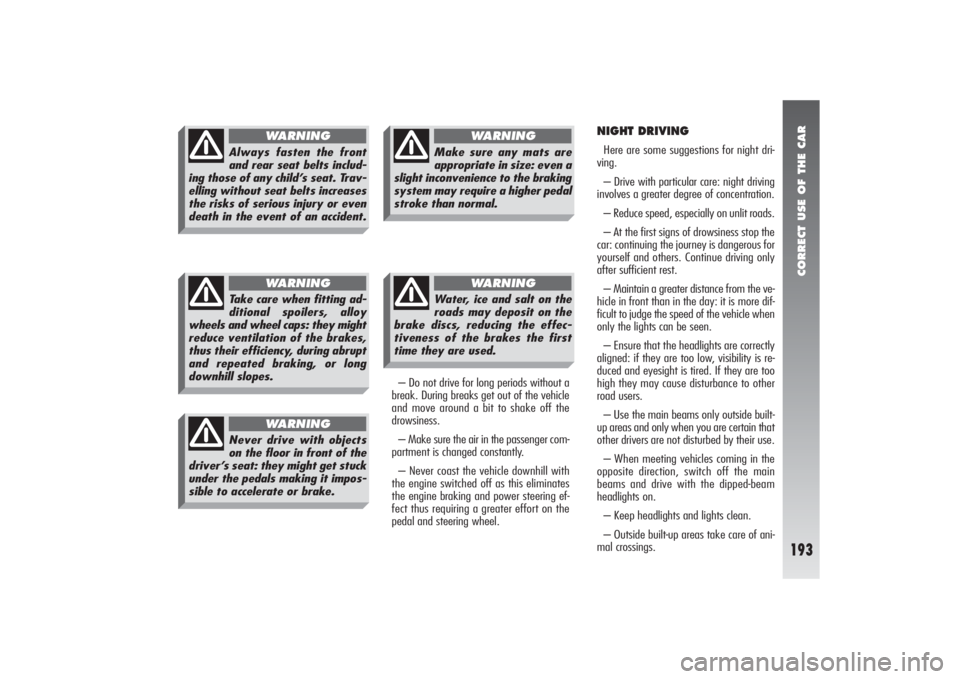
CORRECT USE OF THE CAR
193
– Do not drive for long periods without a
break. During breaks get out of the vehicle
and move around a bit to shake off the
drowsiness.
– Make sure the air in the passenger com-
partment is changed constantly.
– Never coast the vehicle downhill with
the engine switched off as this eliminates
the engine braking and power steering ef-
fect thus requiring a greater effort on the
pedal and steering wheel.
NIGHT DRIVINGHere are some suggestions for night dri-
ving.
– Drive with particular care: night driving
involves a greater degree of concentration.
– Reduce speed, especially on unlit roads.
– At the first signs of drowsiness stop the
car: continuing the journey is dangerous for
yourself and others. Continue driving only
after sufficient rest.
– Maintain a greater distance from the ve-
hicle in front than in the day: it is more dif-
ficult to judge the speed of the vehicle when
only the lights can be seen.
– Ensure that the headlights are correctly
aligned: if they are too low, visibility is re-
duced and eyesight is tired. If they are too
high they may cause disturbance to other
road users.
– Use the main beams only outside built-
up areas and only when you are certain that
other drivers are not disturbed by their use.
– When meeting vehicles coming in the
opposite direction, switch off the main
beams and drive with the dipped-beam
headlights on.
– Keep headlights and lights clean.
– Outside built-up areas take care of ani-
mal crossings.
Always fasten the front
and rear seat belts includ-
ing those of any child’s seat. Trav-
elling without seat belts increases
the risks of serious injury or even
death in the event of an accident.
WARNING
Take care when fitting ad-
ditional spoilers, alloy
wheels and wheel caps: they might
reduce ventilation of the brakes,
thus their efficiency, during abrupt
and repeated braking, or long
downhill slopes.
WARNING
Never drive with objects
on the floor in front of the
driver’s seat: they might get stuck
under the pedals making it impos-
sible to accelerate or brake.
WARNING
Make sure any mats are
appropriate in size: even a
slight inconvenience to the braking
system may require a higher pedal
stroke than normal.
WARNING
Water, ice and salt on the
roads may deposit on the
brake discs, reducing the effec-
tiveness of the brakes the first
time they are used.
WARNING
Page 209 of 357

IN AN EMERGENCY
207
STARTING BY INERTIA
IN THE EVENT OF A
PUNCTUREWARNINGIf the car is equipped with
“Fix&Go kit for tyre quick repair”, see the
instructions contained in the following
chapter.GENERAL INSTRUCTIONSWheel changing and correct use of the jack
and compact spare wheel call for some pre-
cautions as mentioned below. Never push, tow or coast
start the vehicle. This could
cause fuel to flow into the
catalyst damaging it irreversibly.
Remember that the engine
brake and power steering
are not operational until the engine
is started, therefore, much greater
effort than usual is needed on the
brake pedal and steering wheel.
WARNING
Signal the presence of the
stationary vehicle accord-
ing to the current regulations: haz-
ard warning lights, reflecting tri-
angle, etc.
Any passengers should leave the
car and wait for the wheel to be
changed out of harm of the traffic.
If parked on a slope or uneven road
surfaces, place wedges or other
suitable devices under the wheels
to prevent the car from rolling.
Never start the engine when the
car is raised on the jack.
When towing a trailer, always
remove the trailer before lifting
the car.
WARNING
Page 237 of 357
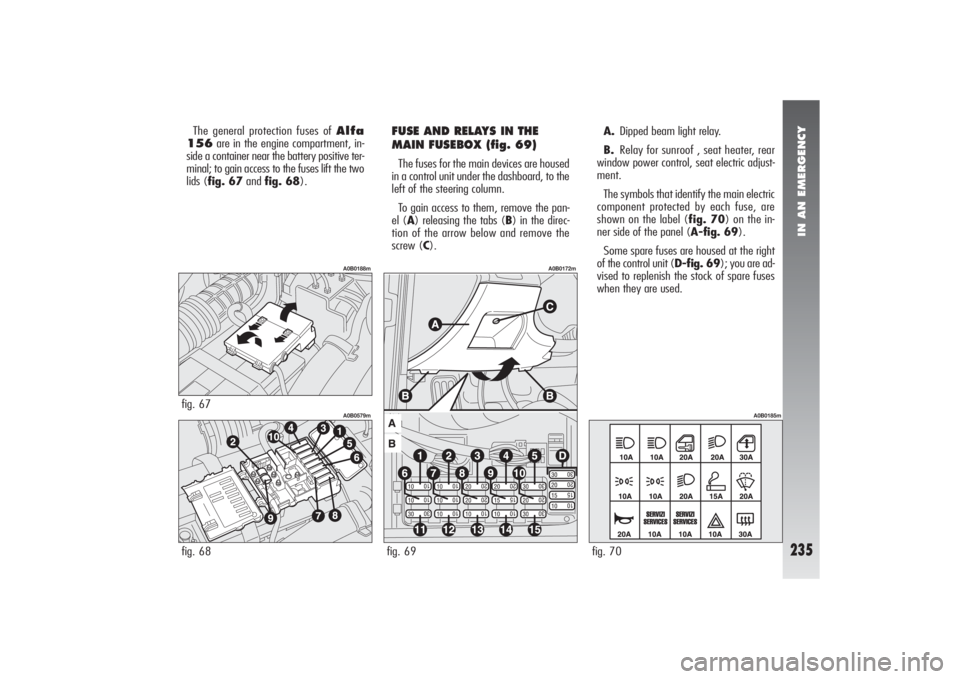
IN AN EMERGENCY
235
The general protection fuses of Alfa
156are in the engine compartment, in-
side a container near the battery positive ter-
minal; to gain access to the fuses lift the two
lids (fig. 67and fig. 68).
FUSE AND RELAYS IN THE
MAIN FUSEBOX (fig. 69)The fuses for the main devices are housed
in a control unit under the dashboard, to the
left of the steering column.
To gain access to them, remove the pan-
el (A) releasing the tabs (B) in the direc-
tion of the arrow below and remove the
screw (C).A.Dipped beam light relay.
B.Relay for sunroof , seat heater, rear
window power control, seat electric adjust-
ment.
The symbols that identify the main electric
component protected by each fuse, are
shown on the label (fig. 70) on the in-
ner side of the panel (A-fig. 69).
Some spare fuses are housed at the right
of the control unit (D-fig. 69); you are ad-
vised to replenish the stock of spare fuses
when they are used.
fig. 68
A0B0579m
fig. 67
A0B0188m
fig. 69
A0B0172m
fig. 70
A0B0185m
Page 245 of 357

IN AN EMERGENCY
243
IF THE VEHICLE IS TO BE TOWEDThe tow ring supplied with the vehicle is
housed in the tool box under the boot mat.
To install the tow ring, proceed as follows:
– Take the tow ring from the tool box.
– Remove the cover (A) snap-fitted on the
front (fig. 77) or rear bumper (fig. 78).
If the supplied flat screwdriver is used to car-
ry out this operation, protect the tip with a
soft cloth to prevent damaging the car.– Firmly screw the ring in its housing.fig. 77
A0B0593m
fig. 78
A0B0594m
Carefully clean the thread-
ed housing before tighten-
ing the ring. Before beginning to
tow the car make sure that the
tow ring is firmly tightened in its
threaded housing.
WARNING
Before beginning to tow
the car, turn the ignition
key to MAR and then to STOP, do
not remove it. Removing the key
automatically engages the steering
lock resulting in the impossibility
to steer the wheels. When towing
remember that without the help of
the servo-brake and power steer-
ing, it is necessary to exert more
effort on the brake pedal and for
steering. Do not use flexible cables
for towing and avoid jerks. Dur-
ing towing operations make sure
that fastening the joint to the car
does not damage the components
in contact with it. When towing the
car it is compulsory to comply with
the specific traffic regulations con-
cerning both the towing device and
behaviour on the road.
WARNING
Page 252 of 357
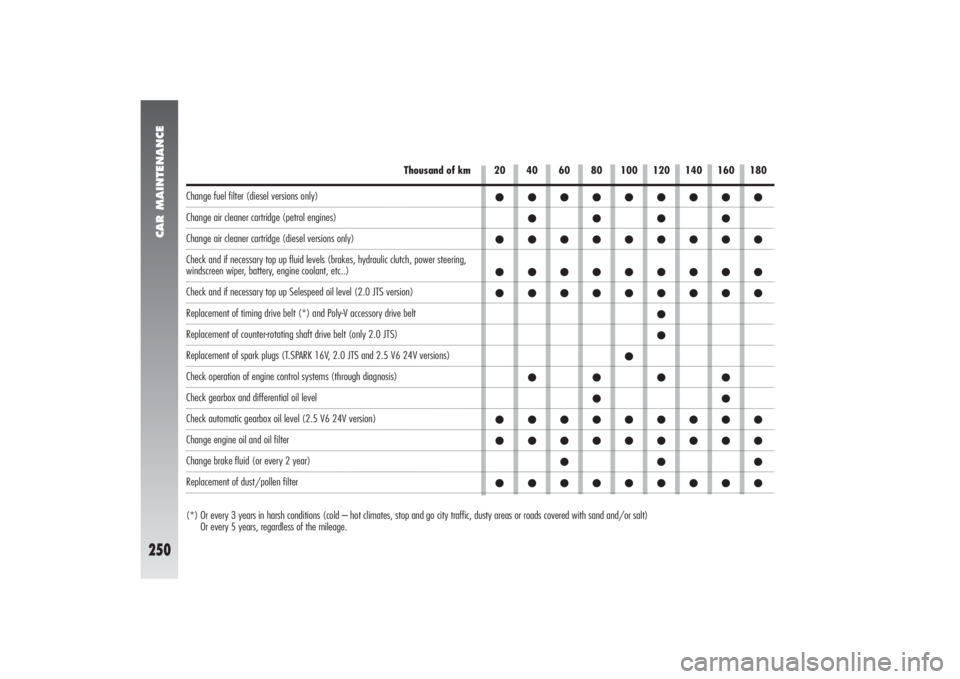
CAR MAINTENANCE
250
20 40 60 80 100 120 140 160 180
Thousand of km
Change fuel filter (diesel versions only)Change air cleaner cartridge (petrol engines)Change air cleaner cartridge (diesel versions only)
Check and if necessary top up fluid levels (brakes, hydraulic clutch, power steering, windscreen wiper, battery, engine coolant, etc..) Check and if necessary top up Selespeed oil level (2.0 JTS version)Replacement of timing drive belt (*) and Poly-V accessory drive beltReplacement of counter-rotating shaft drive belt (only 2.0 JTS)Replacement of spark plugs (T.SPARK 16V, 2.0 JTS and 2.5 V6 24V versions) Check operation of engine control systems (through diagnosis)Check gearbox and differential oil levelCheck automatic gearbox oil level (2.5 V6 24V version)Change engine oil and oil filterChange brake fluid (or every 2 year)Replacement of dust/pollen filter
●●●●●●●●●
●●●●
●●●●●●●●●
●●●●●●●●●
●●●●●●●●●
●
●
●
●●●●
●●
●●●●●●●●●
●●●●●●●●●
●●●
●●●●●●●●●
(*) Or every 3 years in harsh conditions (cold – hot climates, stop and go city traffic, dusty areas or roads covered with sand and/or salt)
Or every 5 years, regardless of the mileage.
Page 253 of 357
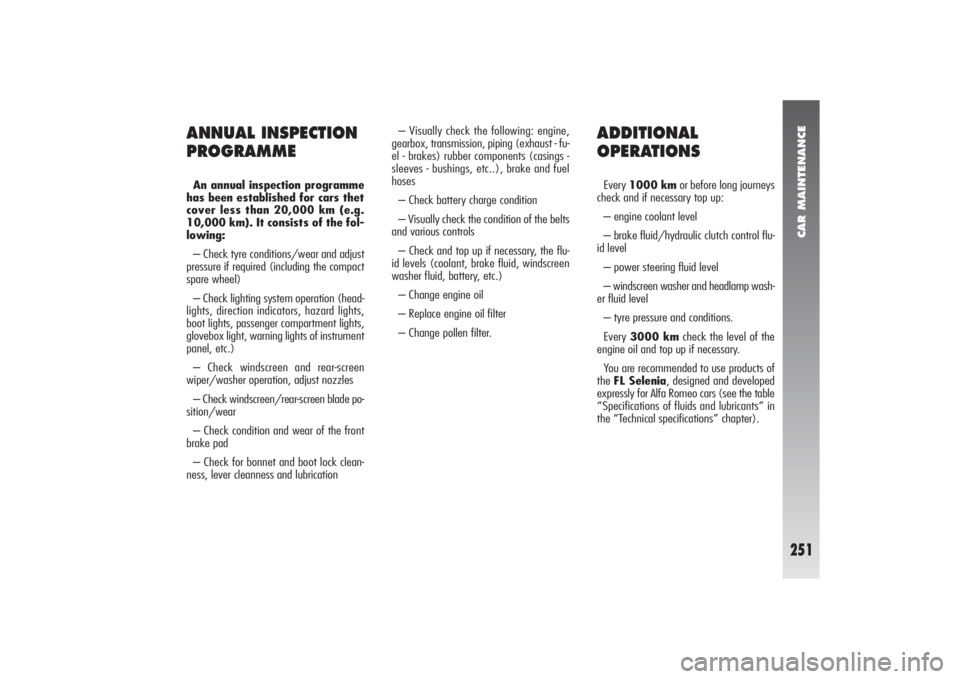
CAR MAINTENANCE
251
ADDITIONAL
OPERATIONSEvery 1000 kmor before long journeys
check and if necessary top up:
– engine coolant level
– brake fluid/hydraulic clutch control flu-
id level
– power steering fluid level
– windscreen washer and headlamp wash-
er fluid level
– tyre pressure and conditions.
Every 3000 kmcheck the level of the
engine oil and top up if necessary.
You are recommended to use products of
the FL Selenia, designed and developed
expressly for Alfa Romeo cars (see the table
“Specifications of fluids and lubricants” in
the “Technical specifications” chapter).
ANNUAL INSPECTION
PROGRAMMEAn annual inspection programme
has been established for cars thet
cover less than 20,000 km (e.g.
10,000 km). It consists of the fol-
lowing:
– Check tyre conditions/wear and adjust
pressure if required (including the compact
spare wheel)
– Check lighting system operation (head-
lights, direction indicators, hazard lights,
boot lights, passenger compartment lights,
glovebox light, warning lights of instrument
panel, etc.)
– Check windscreen and rear-screen
wiper/washer operation, adjust nozzles
– Check windscreen/rear-screen blade po-
sition/wear
– Check condition and wear of the front
brake pad
– Check for bonnet and boot lock clean-
ness, lever cleanness and lubrication– Visually check the following: engine,
gearbox, transmission, piping (exhaust - fu-
el - brakes) rubber components (casings -
sleeves - bushings, etc..), brake and fuel
hoses
– Check battery charge condition
– Visually check the condition of the belts
and various controls
– Check and top up if necessary, the flu-
id levels (coolant, brake fluid, windscreen
washer fluid, battery, etc.)
– Change engine oil
– Replace engine oil filter
– Change pollen filter.